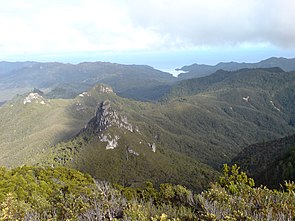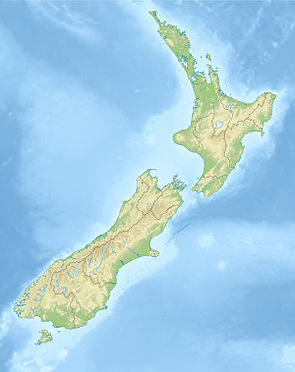Aotea Conservation Park
| Aotea Conservation Park | ||
| Geographical location | ||
|
|
||
| Coordinates | 36 ° 11 ′ S , 175 ° 23 ′ E | |
| Country : | New Zealand | |
| Region (s) : | Auckland | |
| Location: | northeast of Auckland and the Hauraki Gulf | |
| Protected area | ||
| Protected area type: | Conservation Park | |
| Founded: | April 2015 | |
| expansion | ||
| Number of areas: | 11 | |
| Length : | 23 km | |
| Width : | Max. 10 km | |
| Area : | 122.82 km² | |
| The Office Department of Conservation | ||
| Office: |
Tāmaki Makaurau / Auckland Visitor Center Shop2, Shed 19, Princes Wharf 137 Princes Wharf Auckland 1010 |
|
| Photography from Conservation Park | ||
 View from Mount Hobson towards the southwest to Whangaparapara Harbor |
||
The Aotea Conservation Park is a national park on the island of Great Barrier Iceland that the area of North Island of New Zealand is counted. The park is subordinate to the Department of Conservation .
Origin of name
Aotea is the ancestral land of the Ngāti Rehua , Hapū of the Ngāti Wai and the southeastern point of land of the Ngāti Wai . The name is borrowed from the Aotea Waka , the canoe with which part of the Māori once reached New Zealand around 1350 . In the tradition of this mythology, the Great Barrier Island got its Māori name and was also named the Conservation Park .
geography
The Aotea Conservation Park , which refers to the 85-km north-east from the center of Auckland remote island Great Barrier Iceland is, covered with its size of 12,282 hectares from approximately 43% of the area of the island. The Conservation Park consists of eleven individual areas, of which the largest area has a length extension of 23 km from the northern tip to the south and at the widest point extends over around 10 km. The next larger individual area is located with the wetland around the lagoon of the Whangapoua Estuary and the remaining smaller areas are distributed over the southern part of the island.
Administratively, the island with the park belongs to the Auckland Council .
history
In August 2013, the Environment Commissioner of the New Zealand Parliament presented a report on the nature conservation situation on Great Barrier Island . The parliamentarian Nikki Kaye of the New Zealand National Party then used the report as an opportunity to apply in September to place the 18-block land, which was owned by the public, under nature protection. The Minister for Nature Conservation opened a formal investigation into the proposal in October and made a discussion paper available with a public hearing in December of the same year. The project found 2,754 supporters and the Geographic Board determined the future name. After investing NZ $ 2.5 million in repairs, the Minister OK was given in July 2014 to start the Conservation Park . The park opened in April 2015.
Flora and fauna
Great Barrier Island was originally covered with kauri trees, but European immigrants cleared large parts of the forest. Today's hiking trails in the forest were partly the logging routes of the forest workers. In some areas the Kauri forest still exists, but the trees are threatened by the fungus Phytophthora agathidicida , which attacks the roots of the tree and causes it to die.
Kānuka trees and Mānuka bushes dominate the landscape nowadays, but trees like Pōhutukawa , Taraire , Puriri and the Kauri have also spread again. Plants that are normally endangered by animal browsing, such as Kirk's daisy , Pimelea tomentosa and the sand tussock , have also survived on the island. Three plants are unique to the island, such as a subspecies of the Hebe , the prostrate kānuka and the Great Barrier tree daisy .
The island is also home to thirteen different species of skinks and geckos, and the only species of Hochstetter frog found on an island . Some bird species that are rare in New Zealand can also be found on the island. The brown and very loud North Island Kākā deserves a special mention here, which is preferred to be found in the forests.
Web links
- Great Barrier Island / Aotea . (PDF; 7.0 MB)Department of Conservation, October 2019,accessed on February 11, 2020.
Individual evidence
- ↑ Great Barrier Island / Aotea . 2019, p. 2 , accessed on February 11, 2020 .
- ↑ a b Aotea Conservation Park Advisory Committee . Department of Conservation , accessed February 11, 2020 .
- ^ Aotea Conservation Park . Department of Conservation , accessed February 11, 2020 .
- ↑ New Aotea Conservation Park approved . In: Sccop Parliament . Sccop Media , July 20, 2014, accessed February 11, 2020 (New Zealand government press release).
- ↑ Great Barrier Island / Aotea . 2019, p. 5 , accessed on February 11, 2020 .
- ↑ What is Kauri Dieback desease? . In: Keep Kauri Standing . Ministry for Primary Industries , p. 5 , accessed February 11, 2020 .
- ↑ Great Barrier Island / Aotea . 2019, p. 11 f. , accessed on February 11, 2020 .
- ↑ Great Barrier Island / Aotea . 2019, p. 13 f. , accessed on February 11, 2020 .
